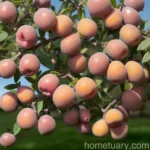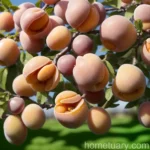Almond (Prunus dulcis): A Comprehensive Guide for Cultivation and Care
The almond tree (Prunus dulcis), known for its nutritious nuts and beautiful blossoms, has been cultivated for thousands of years. It is native to the Middle East and South Asia, where it has been an integral part of various cultures and cuisines. In this comprehensive guide, we will explore the culture, uses, and care techniques for the almond tree, focusing on its botanical characteristics, cultivation requirements, common diseases, and pest management. Additionally, we will highlight interesting facts and useful tips for enthusiasts and horticulturists.
What is Plant: Almond (Prunus dulcis)
Almond (Prunus dulcis) is a small deciduous tree belonging to the Rosaceae family. It is a close relative of the peach and exhibits similar pink or white blossoms in early spring. The tree typically reaches a height of 13 to 26 feet (4 to 8 meters) and is characterized by its gray, deeply furrowed bark.
Key Takeaways – Almond (Prunus dulcis)
- Scientific Name: Prunus dulcis
- Common Name: Almond
- Family: Rosaceae
- Uses: Culinary, Medicinal, Ornamental
- Native Range: Middle East, South Asia
- Commercial Cultivation: Worldwide
Let’s delve deeper into the various aspects of almond cultivation and care.
Culture
Uses
Almonds have diverse uses, making them a valuable addition to the garden or agricultural landscape. The primary uses of almonds include:
- Culinary Uses: Almonds are widely used in both sweet and savory dishes, adding a delightful crunch and nutty flavor to various recipes. They are consumed raw, roasted, or used as an ingredient in confectionery, desserts, and savory dishes.
- Medicinal Uses: Almonds are rich in nutrients and known for their health benefits, including the promotion of heart health, improved brain function, and weight management. Almond oil is also utilized in traditional medicine and skincare products.
- Ornamental Uses: The almond tree’s delicate blossoms make it a popular ornamental tree in gardens and landscapes, adding beauty to the surroundings during the spring season.
Water
Almond trees require adequate water to thrive, especially during their active growing season and fruit development. Proper irrigation is crucial for optimal nut production and tree health. The water requirements may vary based on factors such as climate, soil type, and tree age.
Watering Guidelines:
- Young Trees: Newly planted almond trees need regular watering to establish a strong root system. Provide water 2-3 times per week during the first year, ensuring that the soil remains evenly moist but not waterlogged.
- Mature Trees: Once established, mature almond trees generally require deep, infrequent waterings. Monitor the soil moisture and adjust the watering frequency based on the environmental conditions and the tree’s water needs.
Sunlight
Almond trees thrive in full sun, requiring at least 6 to 8 hours of direct sunlight per day to ensure healthy growth and nut production. Adequate sunlight promotes photosynthesis, leading to the development of robust branches, foliage, and blossoms. Plant almond trees in a location with ample sunlight exposure, preferably in a south-facing position for maximum sun exposure throughout the day.
Fertilizer
Proper fertilization is essential for promoting vigorous growth and high-quality nut production in almond trees. Fertilizers can help replenish essential nutrients in the soil, ensuring that the trees have access to the elements necessary for healthy development and fruiting.
Fertilizer Recommendations:
- Nitrogen: Apply nitrogen-rich fertilizers in early spring to support the tree’s initial growth and leaf production. An additional nitrogen application after harvest can promote bud development for the next season.
- Phosphorus and Potassium: These nutrients are crucial for flowering, fruiting, and overall tree vigor. Incorporate a balanced fertilizer with phosphorus and potassium in the early spring to support blossom and nut formation.
Soil
Almond trees prefer well-draining, loamy soils with a slightly acidic to neutral pH range. The soil should offer good aeration and moisture retention while preventing waterlogging, which can lead to root rot and other detrimental conditions. Conduct a soil test to assess the pH and nutrient levels, and amend the soil as needed to create an optimal growing environment for almond trees.
Soil Preparation:
- Soil pH: Aim for a pH range of 6.0 to 7.5 for almond cultivation. Use lime to raise the pH if the soil is too acidic, or incorporate elemental sulfur to lower the pH if it is too alkaline.
- Organic Matter: Enrich the soil with organic matter such as compost or well-rotted manure to improve soil structure and fertility. Incorporate organic amendments into the planting area to provide a nutrient-rich foundation for the young almond tree.
Pruning
Pruning is an essential practice for maintaining the health, shape, and productivity of almond trees. Proper pruning can promote robust growth, improve air circulation within the canopy, and facilitate the development of fruit-bearing wood. Regular pruning also helps remove diseased or damaged branches, supporting overall tree vigor and disease resistance.
Key Pruning Objectives:
- Shaping the Canopy: Prune to establish a well-balanced and open canopy structure that allows sunlight penetration and airflow throughout the tree.
- Removing Deadwood: Periodically remove dead, diseased, or broken branches to prevent the spread of pathogens and maintain the tree’s vitality.
- Thinning the Canopy: Thinning out excessive growth and overcrowded branches can improve fruit quality, enhance light exposure, and reduce the risk of pest and disease infestations.
Propagation
Almond trees can be propagated through various methods, including seed propagation, cutting propagation, and grafting. Each propagation technique has its advantages and considerations, depending on the desired outcome, resources, and expertise available.
Propagation Methods:
- Seed Propagation: Propagation from seeds is possible, but it may not produce true-to-type almond trees and can result in variability in fruit quality and characteristics.
- Cutting Propagation: Propagating from semi-hardwood cuttings can yield genetically identical clones of the parent tree, preserving desirable traits and characteristics.
- Grafting: Grafting onto compatible rootstocks is a common propagation method in commercial almond production, allowing for precise control over tree characteristics and performance.
Container Popularity
Almond trees can thrive in containers, making them a popular choice for gardeners and enthusiasts with limited space or those interested in growing their own fresh almonds at home. Container-grown almond trees can be placed on patios, balconies, or small garden spaces, providing an opportunity to enjoy the beauty and harvest of almonds in a confined setting.
Benefits of Container-Grown Almond Trees:
- Space Efficiency: Container planting allows individuals with limited outdoor space to cultivate almond trees, making it suitable for urban and suburban environments.
- Portability: Containers offer the flexibility to move the almond tree to different locations based on sunlight, temperature, or aesthetic considerations.
- Ornamental Value: Container-grown almond trees can serve as attractive ornamental additions to outdoor living areas, enhancing the visual appeal of the surroundings.
Common Diseases
Almond trees are susceptible to various diseases that can affect their overall health and productivity. Understanding the symptoms, preventive measures, and treatment options for common almond tree diseases is essential for maintaining a thriving orchard or landscape with healthy, disease-resistant trees.
Common Almond Tree Diseases:
- Shot Hole Disease (Wilsonomyces carpophilus): This fungal disease causes circular, brown spots on leaves and can lead to defoliation under severe infestations. Implementing proper sanitation and fungicidal treatments can help manage this disease.
- Blossom Blight (Monilinia laxa): Blossom blight can cause flower and young shoot dieback, impacting fruit set and tree vigor. Pruning infected branches and applying fungicides during the bloom period can help control this disease.
- Crown Gall (Agrobacterium tumefaciens): Crown gall is characterized by tumor-like growths on the tree’s roots and lower trunk. Planting certified disease-free nursery stock and maintaining proper soil drainage can aid in preventing crown gall.
- Leaf Curl (Taphrina deformans): Leaf curl disease results in distorted and discolored leaves, affecting the tree’s overall vigor and photosynthetic capacity. Proper timing of fungicidal sprays and cultural practices can mitigate leaf curl incidence.
Disease Diagnosis
Accurate diagnosis of almond tree diseases is crucial for implementing effective management strategies and preventing the spread of pathogens within the orchard or landscape. Timely identification of disease symptoms and signs can guide informed decision-making regarding treatment and control measures.
Diagnostic Considerations:
- Symptom Recognition: Pay attention to visual cues such as leaf discoloration, shoot dieback, cankers, or abnormal growths, which can indicate the presence of specific diseases.
- Laboratory Analysis: Submit samples of affected plant parts to diagnostic laboratories for microscopic examination, culturing, or molecular testing to confirm the presence of pathogens and identify the causative agents.
Common Pests
Almond trees can fall victim to various insect pests that can harm foliage, blossoms, and nuts, impacting tree health and nut quality. Implementing integrated pest management (IPM) strategies and timely intervention can help minimize pest damage while preserving the ecological balance in the orchard or landscape.
Significant Almond Tree Pests:
- Navel Orangeworm (Amyelois transitella): Navel orangeworm larvae can infest almond nuts, leading to internal damage and quality degradation. Monitoring moth activity and implementing cultural and chemical controls can manage navel orangeworm populations.
- Spider Mites (Tetranychus spp.): Spider mite infestations can cause leaf stippling, webbing, and reduced photosynthetic efficiency in almond trees. Mitigate spider mite populations through the application of horticultural oils, predatory mites, or insecticidal soaps.
- Scale Insects (Pseudaulacaspis spp.): Scale insects can colonize almond tree branches and twigs, sapping plant sap and causing canopy decline. Implementing cultural controls and targeted insecticide applications can help manage scale insect populations effectively.
Botanist’s Tips
Whether you are an aspiring botanist or a seasoned horticulturist, these tips can enhance your understanding of almond tree cultivation and care, contributing to successful orchard management and healthy, productive trees.
Botanical Insights:
- Bee Pollination: Almond trees depend on insect pollination, particularly by honeybees, to achieve optimal nut set and yield. Ensuring adequate bee populations and pollination services is critical for commercial almond production.
- Late Frost Protection: Protect almond blossoms from potential late spring frost damage by utilizing frost protection measures, such as overhead sprinklers, wind machines, or row covers, to safeguard the tender blooms.
- Beneficial Microorganisms: Incorporate mycorrhizal fungi and beneficial bacteria into the soil to enhance nutrient uptake, root development, and overall tree resilience, contributing to sustainable orchard practices.
Fun Facts
Uncover intriguing and delightful facts about almonds and the almond tree that showcase the remarkable attributes and cultural significance of this beloved plant.
Did You Know?
- Almonds are not true nuts, but rather seeds of the almond fruit, known for their rich flavor and nutrient density.
- The iconic almond blossom, celebrated for its beauty and symbolism, is a prominent subject in art, literature, and cultural traditions, particularly in regions where almond trees bloom abundantly.
Now that we’ve explored various facets of almond tree cultivation and care, let’s delve into external resources for additional insights and information.
Links to External Resources
- Almond Board of California
- University of California Agriculture and Natural Resources – Almond Production Manual
- United States Department of Agriculture (USDA) – Almond Crop Information
- The Almond Tree: Botany, Production, and Uses
By leveraging these resources, enthusiasts, farmers, and horticulturalists can gain in-depth knowledge and practical guidance on almond tree cultivation, pest management, and industry trends.
In conclusion, the almond tree (Prunus dulcis) stands as a testament to the enduring appeal of fruit-bearing trees that contribute to culinary traditions, cultural heritage, and sustainable agriculture. Embracing the holistic approach outlined in this guide—from soil preparation and irrigation to disease management and propagation—empowers individuals to cultivate and care for almond trees effectively, ensuring bountiful harvests and the perpetuation of this beloved botanical treasure.















